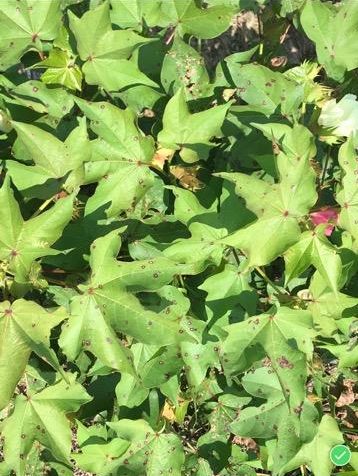Cotton Cercospora Leaf Spot Observed Across NC
go.ncsu.edu/readext?615370
en Español / em Português
El inglés es el idioma de control de esta página. En la medida en que haya algún conflicto entre la traducción al inglés y la traducción, el inglés prevalece.
Al hacer clic en el enlace de traducción se activa un servicio de traducción gratuito para convertir la página al español. Al igual que con cualquier traducción por Internet, la conversión no es sensible al contexto y puede que no traduzca el texto en su significado original. NC State Extension no garantiza la exactitud del texto traducido. Por favor, tenga en cuenta que algunas aplicaciones y/o servicios pueden no funcionar como se espera cuando se traducen.
Português
Inglês é o idioma de controle desta página. Na medida que haja algum conflito entre o texto original em Inglês e a tradução, o Inglês prevalece.
Ao clicar no link de tradução, um serviço gratuito de tradução será ativado para converter a página para o Português. Como em qualquer tradução pela internet, a conversão não é sensivel ao contexto e pode não ocorrer a tradução para o significado orginal. O serviço de Extensão da Carolina do Norte (NC State Extension) não garante a exatidão do texto traduzido. Por favor, observe que algumas funções ou serviços podem não funcionar como esperado após a tradução.
English
English is the controlling language of this page. To the extent there is any conflict between the English text and the translation, English controls.
Clicking on the translation link activates a free translation service to convert the page to Spanish. As with any Internet translation, the conversion is not context-sensitive and may not translate the text to its original meaning. NC State Extension does not guarantee the accuracy of the translated text. Please note that some applications and/or services may not function as expected when translated.
Collapse ▲Cercospora leaf spot of cotton (Fig. 1), caused Cercospora gossypina (syn. Mycosphaerella gossypina), has been observed across North Carolina cotton growing regions. Foliar symptoms include reddish lesions that enlarge to have white to light brown centers. These symptoms may also be similar to other foliar diseases, like Stemphylium leaf spot or Alternaria leaf spot. Symptoms may also appear similar to target spot due to the presence of concentric rings. For accurate identification, contact your Cooperative Extension Agent and/or submit a sample to the Plant Disease and Insect Clinic.
This disease is usually associated with nutrient-deficient or stressed cotton. While it seems counter-intuitive to our experiences with other leaf spots that are more severe with wet conditions, this disease is often found associated with drought-stressed plants. Plants that are unable to take-up potassium due to insufficient soil moisture or poor-root development are most prone to injury.
Significant losses may be observed from premature defoliation or when multiple foliar diseases are found. Fungicides alone are not an effective control for this disease. Maintaining plant vigor with adequate soil fertility and preventing drought stress through irrigation where possible helps delay the onset and severity of outbreaks. For more information regarding cotton disease management, see the 2019 Cotton Information book.



